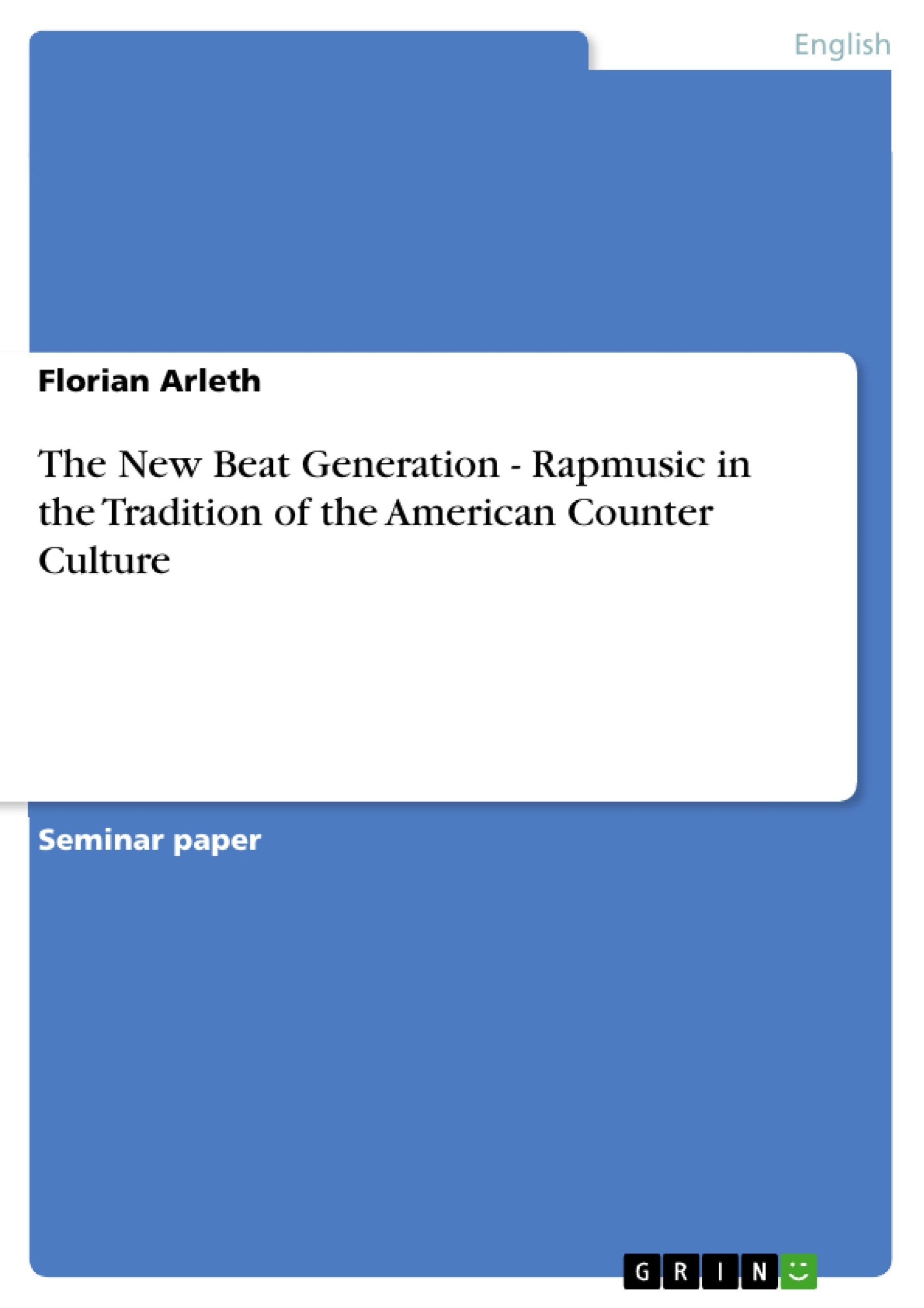As soon as rap music had proven to be something more than a short lived youth phenomenon it began to be acknowledged as an American counter-culture - maybe because of the often controversial lyrics, maybe because of the socio-cultural background of the participants. This paper raises the question if American rap music can be seen as standing in the tradition of the Beat Generation, an artistic and ideological movement that is treated as the foundation of the term Counter Culture as it will be used in the further progress.
The definition of this term is based on three texts: “The Culture of Spontaneity” by Daniel Belgrad, “The White Negroe” by Norman Mailer and “The Philosophy of the Beat Generation” by Jack Kerouac. These works have in common that they are all concerned with the phenomenon of the American Counter-Culture in general and with the Beat Generation in particular - be it from Kerouac's personal point of view, from a contemporary one like Mailer's, or from the scholarly perspective of Belgrad. They each deal with different aspects of this movement and in this give a broad definition of it, including ideological as well as formal points.
These individual notions are then used to construct a basis for a comparison. They are compared to respective aspects in rap music, with no special regard to decades, geographic focal points or stylistic tendencies. The rap culture is rather seen as an entity, the different artists as manifestations of its ideas. This means that the personal views and works of rap musicians are as important as their common denominator and are treated likewise. Yet there needs to be a distinction between those rap artists that create in accordance to the original ideas of Hip Hop and those who compromised on their musical integrity, whether due to the taste of the main stream or to artistic misleadings. The term 'Counter Culture' itself proves to be very helpful here, for it already implies that the followers of this movement oppose the 'Culture' of the mainstream and can therefore not be part of it, like the latter group of rap artists is.
Finally, the aim of this paper is to trace the similarities of the two movements, but also to highlight the differences - the reasons why rap Music should not be considered as part of the American Counter-Culture, as a new Beat Generation.
Inhaltsverzeichnis (Table of Contents)
- Introduction
- Similarities
- Origins and Ideology
- Communities and Non-Commercialness
- Ethnic and Social Background
- Aesthetics
- Spontaneity
- Rejection of Traditional Forms
- Language
- Production
- Mainstream
- Influence of Mainstream
- Commercialization
- Opposition of Mainstream
- Origins and Ideology
- Differences
- Collaborations
- Rejection of Authority
- Conclusion
Zielsetzung und Themenschwerpunkte (Objectives and Key Themes)
This paper explores the similarities and differences between American rap music and the Beat Generation, a counter-cultural movement that emerged in the mid-20th century. The paper examines the origins, ideologies, aesthetic principles, and social contexts of both movements, aiming to determine if rap music can be considered a contemporary manifestation of the Beat Generation's counter-cultural spirit. Key themes of the paper include:- The role of community and non-commerciality in both movements
- The ethnic and social backgrounds of the participants in each movement
- The rejection of traditional forms and the embrace of spontaneity in both rap and Beat literature
- The influence of mainstream culture on both movements
- The unique expressions of resistance and rebellion found in both movements.
Zusammenfassung der Kapitel (Chapter Summaries)
Introduction
This chapter introduces the concept of American rap music as a possible counter-cultural movement, drawing parallels to the Beat Generation. It establishes the definition of "counter-culture" based on key texts by Daniel Belgrad, Norman Mailer, and Jack Kerouac. The chapter sets the foundation for a comparative analysis of rap music and the Beat Generation, examining their commonalities and divergences.Similarities
Origins and Ideology
This section explores the shared emphasis on building a community and rejecting commercialism in both rap and the Beat Generation. It discusses the origins of hip-hop in inner-city communities and its emphasis on collective expression, highlighting the non-commercial origins of both movements.Ethnic and Social Background
This section emphasizes the shared commitment of both movements to challenging the dominant cultural authority. It examines the origins of the Beat Generation and its members' mixed backgrounds, as well as the ethnic and social diversity of rap musicians. The section highlights the shared objective of challenging the prevailing Anglo-American cultural hegemony.Aesthetics
This section explores the artistic similarities between rap and Beat literature, focusing on the concept of spontaneity. It highlights the importance of "freestyle" in rap music and how it echoes the emphasis on spontaneity in Kerouac's "Essentials of Spontaneous Prose." This section also examines the rejection of traditional forms in both movements.Mainstream
This section analyzes the relationship of both movements with mainstream culture. It discusses the influence of mainstream culture on both rap and Beat literature, as well as the opposition and resistance that these movements have faced from commercial forces.Differences
This section, which is not included in this preview, will likely address the distinct features that distinguish rap music from the Beat Generation. It may discuss aspects such as specific creative techniques, artistic expressions, or social contexts that set them apart.Schlüsselwörter (Keywords)
The key concepts and themes of this paper center around the intersections between rap music and the Beat Generation, examining their shared origins, artistic expressions, and social contexts. The analysis explores the shared characteristics of these movements, including their non-commercial origins, emphasis on community, rejection of traditional forms, and expressions of counter-cultural resistance. Key terms explored include: counter-culture, Beat Generation, rap music, hip-hop, community, spontaneity, authenticity, mainstream, commercialization, ethnic background, social background, and cultural authority.- Citar trabajo
- Florian Arleth (Autor), 2010, The New Beat Generation - Rapmusic in the Tradition of the American Counter Culture, Múnich, GRIN Verlag, https://www.grin.com/document/190758



